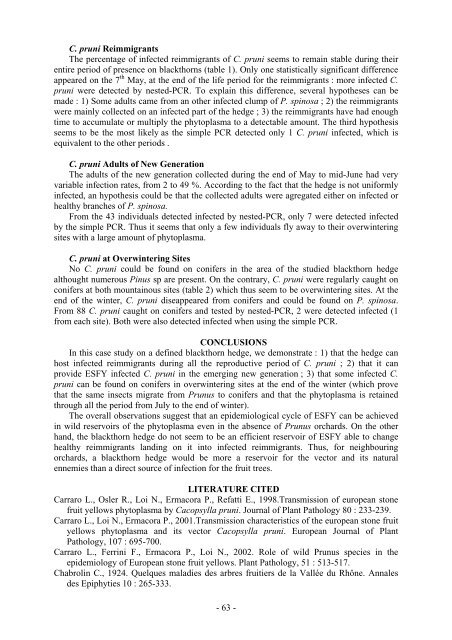Ecole Nationale Supérieure Agronomique de Montpellier ... - CIAM
Ecole Nationale Supérieure Agronomique de Montpellier ... - CIAM
Ecole Nationale Supérieure Agronomique de Montpellier ... - CIAM
You also want an ePaper? Increase the reach of your titles
YUMPU automatically turns print PDFs into web optimized ePapers that Google loves.
C. pruni Reimmigrants<br />
The percentage of infected reimmigrants of C. pruni seems to remain stable during their<br />
entire period of presence on blackthorns (table 1). Only one statistically significant difference<br />
appeared on the 7 th May, at the end of the life period for the reimmigrants : more infected C.<br />
pruni were <strong>de</strong>tected by nested-PCR. To explain this difference, several hypotheses can be<br />
ma<strong>de</strong> : 1) Some adults came from an other infected clump of P. spinosa ; 2) the reimmigrants<br />
were mainly collected on an infected part of the hedge ; 3) the reimmigrants have had enough<br />
time to accumulate or multiply the phytoplasma to a <strong>de</strong>tectable amount. The third hypothesis<br />
seems to be the most likely as the simple PCR <strong>de</strong>tected only 1 C. pruni infected, which is<br />
equivalent to the other periods .<br />
C. pruni Adults of New Generation<br />
The adults of the new generation collected during the end of May to mid-June had very<br />
variable infection rates, from 2 to 49 %. According to the fact that the hedge is not uniformly<br />
infected, an hypothesis could be that the collected adults were agregated either on infected or<br />
healthy branches of P. spinosa.<br />
From the 43 individuals <strong>de</strong>tected infected by nested-PCR, only 7 were <strong>de</strong>tected infected<br />
by the simple PCR. Thus it seems that only a few individuals fly away to their overwintering<br />
sites with a large amount of phytoplasma.<br />
C. pruni at Overwintering Sites<br />
No C. pruni could be found on conifers in the area of the studied blackthorn hedge<br />
althought numerous Pinus sp are present. On the contrary, C. pruni were regularly caught on<br />
conifers at both mountainous sites (table 2) which thus seem to be overwintering sites. At the<br />
end of the winter, C. pruni diseappeared from conifers and could be found on P. spinosa.<br />
From 88 C. pruni caught on conifers and tested by nested-PCR, 2 were <strong>de</strong>tected infected (1<br />
from each site). Both were also <strong>de</strong>tected infected when using the simple PCR.<br />
CONCLUSIONS<br />
In this case study on a <strong>de</strong>fined blackthorn hedge, we <strong>de</strong>monstrate : 1) that the hedge can<br />
host infected reimmigrants during all the reproductive period of C. pruni ; 2) that it can<br />
provi<strong>de</strong> ESFY infected C. pruni in the emerging new generation ; 3) that some infected C.<br />
pruni can be found on conifers in overwintering sites at the end of the winter (which prove<br />
that the same insects migrate from Prunus to conifers and that the phytoplasma is retained<br />
through all the period from July to the end of winter).<br />
The overall observations suggest that an epi<strong>de</strong>miological cycle of ESFY can be achieved<br />
in wild reservoirs of the phytoplasma even in the absence of Prunus orchards. On the other<br />
hand, the blackthorn hedge do not seem to be an efficient reservoir of ESFY able to change<br />
healthy reimmigrants landing on it into infected reimmigrants. Thus, for neighbouring<br />
orchards, a blackthorn hedge would be more a reservoir for the vector and its natural<br />
ennemies than a direct source of infection for the fruit trees.<br />
LITERATURE CITED<br />
Carraro L., Osler R., Loi N., Ermacora P., Refatti E., 1998.Transmission of european stone<br />
fruit yellows phytoplasma by Cacopsylla pruni. Journal of Plant Pathology 80 : 233-239.<br />
Carraro L., Loi N., Ermacora P., 2001.Transmission characteristics of the european stone fruit<br />
yellows phytoplasma and its vector Cacopsylla pruni. European Journal of Plant<br />
Pathology, 107 : 695-700.<br />
Carraro L., Ferrini F., Ermacora P., Loi N., 2002. Role of wild Prunus species in the<br />
epi<strong>de</strong>miology of European stone fruit yellows. Plant Pathology, 51 : 513-517.<br />
Chabrolin C., 1924. Quelques maladies <strong>de</strong>s arbres fruitiers <strong>de</strong> la Vallée du Rhône. Annales<br />
<strong>de</strong>s Epiphyties 10 : 265-333.<br />
- 63 -



